Since switching to digital I've pretty much been a Canon guy, but my first SLR was a Nikon. Nikon D60
Here's the latest Canon announcement as well: Canon XSi
NOTE: I changed the title of the post and added the Canon review.
Tuesday, January 29, 2008
Monday, January 28, 2008
The Great Backyard Bird Count
The Great Backyard Bird Count is happening February 15-18. This will be my first year participating and I'm looking forward to it. For those of you that might be interested in participating as well it only takes 15 minutes during one of the 4 days that it is scheduled. Here's a link to information about participating: How to Participate.
Sunday, January 27, 2008
Telemetric Egg . . .
This is a great use of technology in my opinion:
"The telemetric egg, placed in the nest after the mother has laid her eggs, contains sensors that record temperatures on four quadrants of the egg’s surface as well as in the egg’s interior. Motion detectors record how frequently the mother turns the egg during incubation. The data are recorded 24 hours a day and downloaded to a computer every 48 hours. National Zoo staff use the information to mimic natural incubation in a controlled setting in the lab. "
Photo Credit: Jessie Cohen, Smithsonian’s National Zoo
Wednesday, January 23, 2008
Learning about birds . . . Pelicans
A friend of mine that reads my blog mentioned that pelicans might be an interesting bird to learn about, so here are a few facts about pelicans. All of these photos were taken at J. N. Ding Darling Wildlife Refuge in Florida.
American White Pelican:
- Unlike most birds, which warm their eggs with the skin of their breasts, pelicans incubate their eggs with their feet. They hold the eggs under the webs that stretch from the front toes to the hind toe, essentially standing on the eggs to warm them.
- The White Pelican does not dive for fish as the Brown Pelican does. Instead, it dips its head underwater to scoop up fish. Several pelicans may fish cooperatively, moving into a circle to concentrate fish, and then dipping their heads under simultaneously to catch fish.
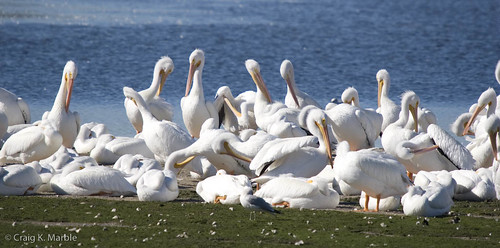
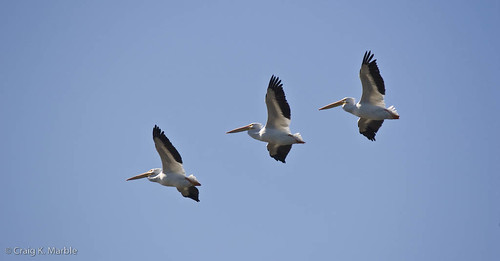

Brown Pelican:
- The Brown Pelican frequently lowers its head onto its shoulders with the bill open, pulls its head back, and stretches the pouch over its throat and neck. The exposed neck looks like a large lump sticking up out of the pouch.
- The brown pelican is a plunge diver. It drops from the air with its wings partly folded and dives into the water to catch its prey. It is the only species of pelican that does this!The brown pelican is a plunge diver. It drops from the air with its wings partly folded and dives into the water to catch its prey. It is the only species of pelican that does this!
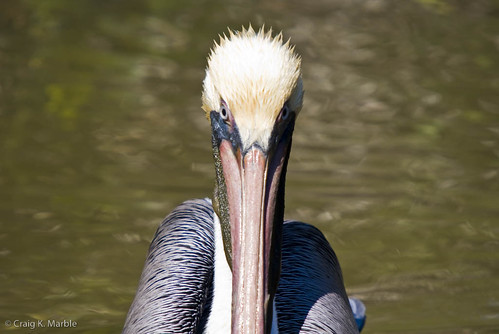
American White Pelican:
- Unlike most birds, which warm their eggs with the skin of their breasts, pelicans incubate their eggs with their feet. They hold the eggs under the webs that stretch from the front toes to the hind toe, essentially standing on the eggs to warm them.
- The White Pelican does not dive for fish as the Brown Pelican does. Instead, it dips its head underwater to scoop up fish. Several pelicans may fish cooperatively, moving into a circle to concentrate fish, and then dipping their heads under simultaneously to catch fish.



Brown Pelican:
- The Brown Pelican frequently lowers its head onto its shoulders with the bill open, pulls its head back, and stretches the pouch over its throat and neck. The exposed neck looks like a large lump sticking up out of the pouch.
- The brown pelican is a plunge diver. It drops from the air with its wings partly folded and dives into the water to catch its prey. It is the only species of pelican that does this!The brown pelican is a plunge diver. It drops from the air with its wings partly folded and dives into the water to catch its prey. It is the only species of pelican that does this!

Sunday, January 20, 2008
The last of the Hawaiian birds . . .
Just to finish off this thread, it's about -8 degrees (F) right now, so thoughts of warm weather are still in my mind. I'll be heading over to my fathers so we can watch the NFL playoffs, but I'll be honest, I'm not really looking forward to going outside. Anyway, enough whining from me about the cold. Here are two more shots showing those beautiful birds from Hawaii:
Black Swan:
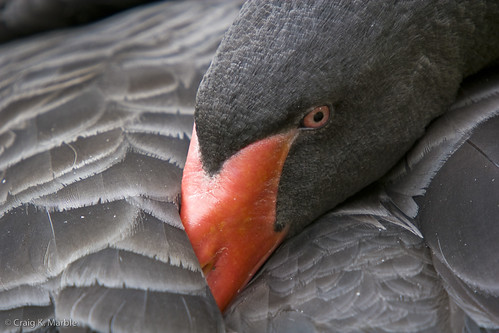
Red-footed Booby:
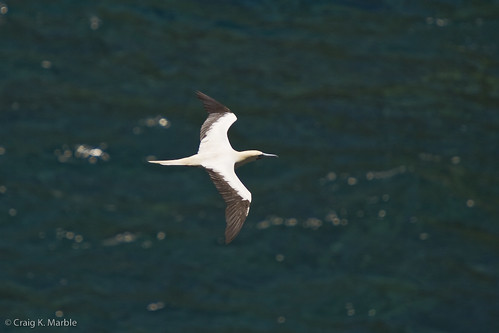
By the way, I took the shots of the Frigatebird, Red-footed Booby, Nene, and Red-tailed Tropicsbird at the Kilauea Lighthouse on the island of Kauai. It's definitely worth a visit if you're there.
Black Swan:

Red-footed Booby:

By the way, I took the shots of the Frigatebird, Red-footed Booby, Nene, and Red-tailed Tropicsbird at the Kilauea Lighthouse on the island of Kauai. It's definitely worth a visit if you're there.
Saturday, January 19, 2008
Still cold . . . what the frigate is up with that . . .
Yeah it's still cold, in fact, it's now -6 degrees (F) with a windchill of about -20 and it's supposed to drop even farther. So, as stated in my earlier post, I'm now sitting by the fire and staying warm. How about a few more Hawaiin birds!
Back in November I had posted about the Audobon Watch List. Here are 2 birds from that watchlist:
Magnificent Frigatebird:
"The U. S. Fish and Wildlife Service considers this unique seabird a "species of conservation concern," while Partners in Flight label it a "species of high concern," due to its decreasing population and threats to its breeding habitat. "
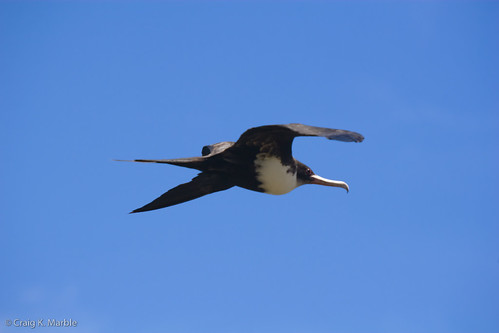
Nene (Hawaiian Goose):
"After a close call with extinction, it remains as Hawaii's state bird. It is one of the most isolated, sedentary, and threatened of all water birds. Hunting, poaching and egg collecting took a heavy toll through the early 1900's. Despite tenacious re-introduction efforts beginning in the 1960's, the population still has not recuperated to a self sustaining condition. "
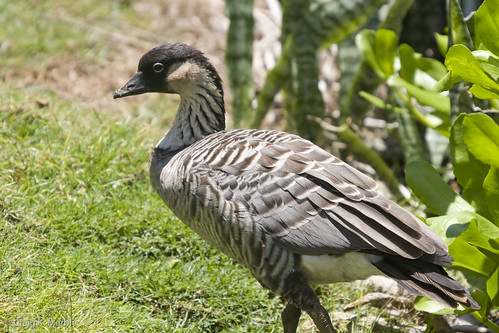
Back in November I had posted about the Audobon Watch List. Here are 2 birds from that watchlist:
Magnificent Frigatebird:
"The U. S. Fish and Wildlife Service considers this unique seabird a "species of conservation concern," while Partners in Flight label it a "species of high concern," due to its decreasing population and threats to its breeding habitat. "

Nene (Hawaiian Goose):
"After a close call with extinction, it remains as Hawaii's state bird. It is one of the most isolated, sedentary, and threatened of all water birds. Hunting, poaching and egg collecting took a heavy toll through the early 1900's. Despite tenacious re-introduction efforts beginning in the 1960's, the population still has not recuperated to a self sustaining condition. "

Friday, January 18, 2008
Thinking warm . . . Hawaiian birds . . .
Well it's about 1 degree (F) right now, and that is likely to be the warmest it will be for the next few days. They are predicting a low of -17 (F) tonight, which honestly is pretty cold. I enjoy the winter. I don't mind the cold . . . within reason. This kind of cold snap, gets old quickly so I'll likely be sitting by the fire this weekend.
As I was cruising through some old photos (work related stuff) I came across the set of bird photos I took while in Hawaii May of 2005. So these are bit old, but they do remind me of a warmer time. :)
Red-tailed Tropicbird:

White-rumped Sharma:
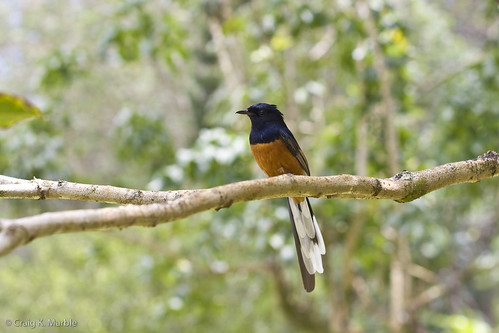
As I was cruising through some old photos (work related stuff) I came across the set of bird photos I took while in Hawaii May of 2005. So these are bit old, but they do remind me of a warmer time. :)
Red-tailed Tropicbird:

White-rumped Sharma:

Sunday, January 13, 2008
Learning about birds . . . White-breasted Nuthatch
The White-breasted Nuthatch is a frequent visitor to our yard. We regularly have 2 (likely a pair) at the feeder. These birds are commonly found in deciduous forests and wooded areas like my yard. Here are some of the fun facts that I have found:
White-breasted Nuthatch:
- Nuthatches gather nuts and seeds, jam them into tree bark, and hammer or "hatch" the food open with their bills.
- White-breasted Nuthatches are monogamous and remain with their partner the whole year from the time of courtship to the creation of a dwelling place or until the partner disappears or dies.
- Aside from being one of a few birds who can creep down a tree trunk head first to forage for food or hang upside down, swinging from tiny branches, the White-breasted Nuthatch is also known to exhibit a weird behavior known as "bill sweeping" in which it picks up a piece of fur, plant or insect with its bill and uses this to sweep around its nest''s cavity. Scientists believe it does this to remove its own scent around the nest and prevent detection by predators.
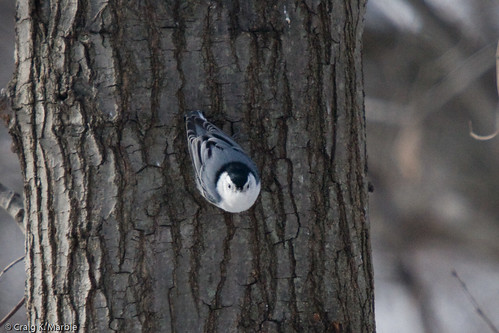
Here's lookin' at ya!
White-breasted Nuthatch:
- Nuthatches gather nuts and seeds, jam them into tree bark, and hammer or "hatch" the food open with their bills.
- White-breasted Nuthatches are monogamous and remain with their partner the whole year from the time of courtship to the creation of a dwelling place or until the partner disappears or dies.
- Aside from being one of a few birds who can creep down a tree trunk head first to forage for food or hang upside down, swinging from tiny branches, the White-breasted Nuthatch is also known to exhibit a weird behavior known as "bill sweeping" in which it picks up a piece of fur, plant or insect with its bill and uses this to sweep around its nest''s cavity. Scientists believe it does this to remove its own scent around the nest and prevent detection by predators.

Here's lookin' at ya!
Saturday, January 05, 2008
Learning about birds in 2008 . . . Great Horned Owl
This year I'm going to work on learning more about the birds in my area, things like their range, habitat, food, behavior, etc. I'm also going to try and find out neat facts (like the ones below) about a particular bird each week. I'll post those to the blog. This week it's going to be the Great Horned Owl . . . for obvious reasons. :)
Great Horned Owl:
- The Great Horned Owl is the only animal that regularly eats skunks.
- Great horned owls pair off to begin mating in early winter. By February, they are already nesting!
- Great horned owls don't make a nest, they take over nests left by other animals.
- Of all the owls, the great horned owl has the strongest talons. About 30 pounds (13,000 grams) of force is required to release the owl's grip on an object.
Great Horned Owl:
- The Great Horned Owl is the only animal that regularly eats skunks.
- Great horned owls pair off to begin mating in early winter. By February, they are already nesting!
- Great horned owls don't make a nest, they take over nests left by other animals.
- Of all the owls, the great horned owl has the strongest talons. About 30 pounds (13,000 grams) of force is required to release the owl's grip on an object.
PS If anyone has a particular bird they would like to learn about , let me know and I'll post on that bird next week.
Wednesday, January 02, 2008
Great Horned Owls
Well, so far this year is going pretty well in terms of birding. Yesterday we had a Rough-legged Hawk flying over my yard for about 5 minutes or so, and tonight we had a pair of Great Horned Owls hooting away out in the cold. We could hear that the one owl was quite close to the house so I grabbed my binoculars and headed outside to see if I could find him. Well, about 10 seconds after walking out the door, still standing on my deck, he hooted away and I spotted him. I picked up the binocs and got a good look at him. The light was fading fast so I grabbed my camera and took 1 photo of him. Before I took the shot, my wife and father-in-law, got a good look at him as well. The shot isn't that great but you sure can tell he's a Great Horned Owl!
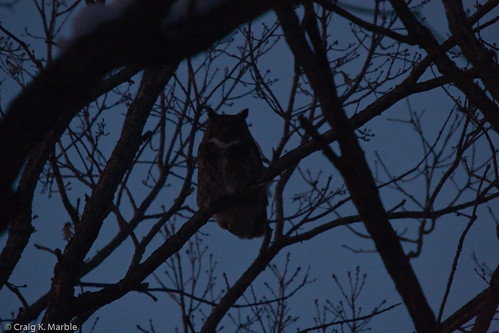

Tuesday, January 01, 2008
Welcome to a New Year
The New Year has arrived and I hope that this year will bring good things to all of us. I decided to start out the New Year with a change to the look of my blog and some photos of the recent snows we have had. The photos are all in my yard, a place that my wife and I find solitude throughout the year.
I wish all of you the best for the coming year and hope that you and your loved ones are in good spirits and health.
Sincerely,
Craig
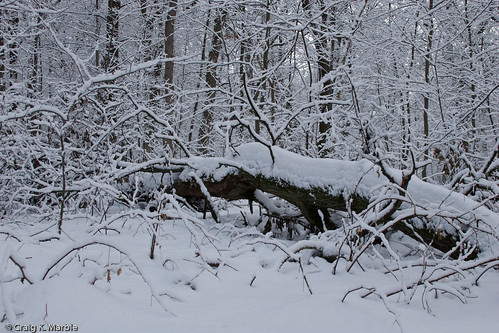
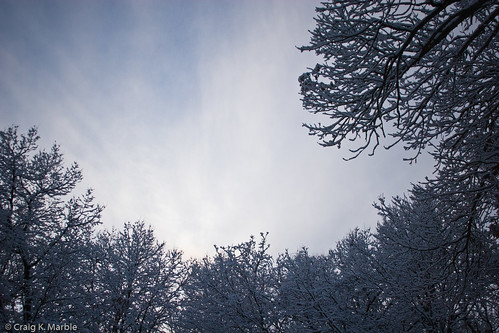

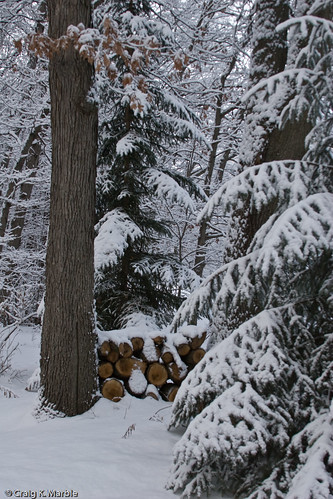

I wish all of you the best for the coming year and hope that you and your loved ones are in good spirits and health.
Sincerely,
Craig





Subscribe to:
Posts (Atom)

